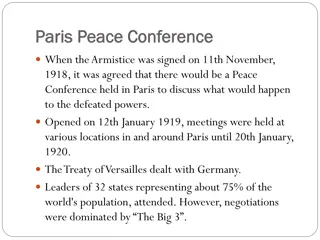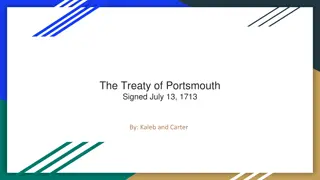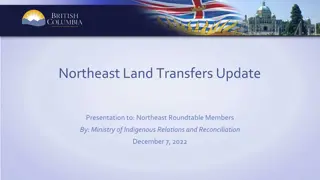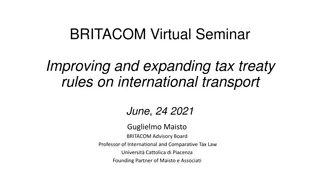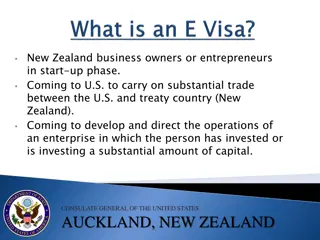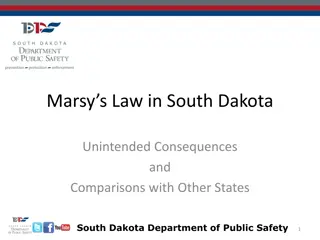University Land Grants and Dakota Treaty Lands in Minnesota
Explore the history of University land grants in Minnesota, dating back to 1851 and the establishment of the University of the Territory of Minnesota. Learn about the grants allocated for the university's support and expansion, including additional townships and acreages granted over the years. Delve into the significance of Dakota Treaty lands, the concept of sovereignty, and the impact of treaties on land ownership. Uncover the complexities surrounding land grants, ownership, and the historical context of the region.
Uploaded on Oct 02, 2024 | 0 Views
Download Presentation

Please find below an Image/Link to download the presentation.
The content on the website is provided AS IS for your information and personal use only. It may not be sold, licensed, or shared on other websites without obtaining consent from the author. Download presentation by click this link. If you encounter any issues during the download, it is possible that the publisher has removed the file from their server.
E N D
Presentation Transcript
WHERE WE STAND Dakota Treaty Lands in Minnesota
University Land Grants The [U.S.] Congress, in February, 1851, one day after the approval by Governor Ramsey of the legislative act creating the University of the Territory of Minnesota, authorized the Secretary of the Interior to set apart two townships, 46,080 acres, for the use and support of the University of the Territory of Minnesota. C.W. Hall, The University of Minnesota: An Historical Sketch, 1896.
University Land Grants In 1857 there was appropriated an additional two townships consisting of a like amount. In 1862 the historic Morrill bill made a grant to the State of Minnesota of 120,000 acres. C.W. Hall, The University of Minnesota: An Historical Sketch, 1896.
University Land Grants What land was granted to the University? Don t know if there are maps Not all of it was land the campus currently sits on Gift of original building site from Regent Steele Purchase of 27 acres of current East Bank in 1854, with money obtained from sale of other lands Much land sold between 1857-1867 to pay off debts incurred in first few years of operation
University Land Grants Whose land was granted to the University? Dakhota land owned by U.S. government U.S government thought it had valid title because of treaties, but
What is a treaty? A formal agreement between two (or more) sovereign nations
What is sovereignty? When a nation/people have the ability to self govern free from external control or influence.
What is a treaty? The Supreme Law of the United States Supremacy Clause U.S. Constitution, Article VI, Clause 2 This Constitution, and the Laws of the United States which shall be made in Pursuance thereof; and all Treaties made, or which shall be made, under the authority of the United States, shall be the supreme Law of the land; and the Judges in every State shall be bound thereby, any Thing in the Constitution or Laws of any State to the Contrary notwithstanding.
Usufructuary Rights The retained right to use land as it was used before to continue to use the land for hunting, fishing, gathering, ceremonies, etc. Because they retained these rights in their treaties, these are referred to as reserved rights. They are not special rights or rights that are given to indigenous peoples by treaty. Ex.: The retained right to fish off reservation land and off season (not subject to state fishing regulations).
Treaty of 1805 between the Dakh ta Oyate and the U.S. Conference Between the United States of America and the Sioux Nation of Indians. Whereas, a conference held between the United States of America and the Sioux Nation of Indians, Lieut. Z. M. Pike, of the Army of the United States, and the chiefs and warriors of the said tribe, have agreed to the following articles, which when ratified and approved of by the proper authority, shall be binding on both parties: ARTICLE 1. That the Sioux Nation grants unto the United States for the purpose of the establishment of military posts, nine miles square at the mouth of the river St. Croix, also from below the confluence of the Mississippi and St. Peters, up the Mississippi, to include the falls of St. Anthony, extending nine miles on each side of the river. That the Sioux Nation grants to the United States, the full sovereignty and power over said districts forever, without any let or hindrance whatsoever. ARTICLE 2. That in consideration of the above grants the United States (shall, prior to taking possession thereof, pay to the Sioux two thousand dollars, or deliver the value thereof in such goods and merchandise as they shall choose). ARTICLE 3. The United States promise on their part to permit the Sioux to pass, repass, hunt or make other uses of the said districts, as they have formerly done, without any other exception, but those specified in article first. In testimony hereof, we, the undersigned, have hereunto set our hands and seals, at the mouth of the river St. Peters, on the 23rd day of September, one thousand eight hundred and five. Z. M. Pike, [SEAL.] First Lieutenant and Agent at the above conference. Le Petit Carbeau, his x mark. [SEAL.] Way Aga Enogee, his x mark. [SEAL.]
Problems with the 1805 Treaty Signed by two Dakh ta leaders who did not have the authority to speak for the entire nation Pike left the amount to be paid blank, but believed the 100,000 acres were equal to $200,000 President Thomas Jefferson didn t submit the Treaty to the Senate for ratification until March 29, 1808. The Senate ratified the treaty on April 13th, with the following amendment to fill the blank in article 2, viz: After the word States in the second article insert the following words: shall, prior to taking possession thereof, pay to the Sioux two thousand dollars, or deliver the value thereof in such goods and merchandise as they shall choose.
Problems with the 1805 Treaty In July 1819, a quantity of goods worth two thousand dollars was sent up the Mississippi River as payment for the treaty On the way, some of the goods were given to several Sac and Fox Indians who came to [the Indian agent] complaining that one of their brothers had been killed by a white man the previous year. When treaty negotiations were underway in 1837, a number of Dakh ta leaders raised the issue that they had never been paid under the terms of the 1805 treaty.
Problems with the 1805 Treaty In 1835, fur trader Henry Sibley asked Indian Agent Lawrence Taliaferro how he viewed the reserve at this Post [Fort Snelling]. Taliaferro wrote in his journal that he answered, my opinion this rese[r]vation at S Peters is nothing more than a perpetual lease under the convention with Pike. The Treaty of 1825 (August) at Prairie du chiens confirms it. It is taken and deemed to be the Indian country in my view of the case by the act of the 30 June 1834 as before stated.
Problems with the 1805 Treaty As late as 1856, however, the title to the land was in question. In that year, the Military Affairs Committee of the Senate issued a report that stated: "It does appear that General Pike made an arrangement in 1805 with two Sioux Indians for the purchase of the lands of that tribe, including the Faribault island, but there is no evidence that this agreement, to which there is not even a witness, and in which no consideration was named, was ever considered binding upon the Indians, or that they ever yielded up the possession of their lands under it.. [I]t was never promulgated, nor can it be now found upon the statute books, like any other treaty if indeed a treaty it may be called nor were its stipulations ever complied with on the part of the United States."
1837 Treaty Dakh ta people ceded all land east of the Mississippi River in exchange for annuity payments Included an education fund of $5,000 per year that Dakh ta leaders assumed would be paid to them directly, but the government planned to spend the money on educational programs including missionary schools this became a huge sticking point in 1851 treaty negotiations.
1851 Treaties of Traverse des Sioux and Mendota Dakh ta people ceded all land remaining land in Minnesota Treaty doesn t specify any land to be reserved for Dakh ta people to live on, but in negotiations and by agreement of the president, a reservation was established along the Minnesota River
Problems with the 1851 Treaty Signed under duress Commissioner of Indian Affairs Luke Lea told the leaders, Suppose your Great Father wanted your lands and did not want a treaty for your good, he could come with 100,000 men and drive you off to the Rocky Mountains. Dakh ta leaders were tricked into signing traders papers a separate document listing what fur traders said were the debts owed to them by individual Dakh tas and agreeing to divert funds from the payment for the land to settle the debts. Even a missionary present at the signing thought the leaders were signing another copy of the treaty.
Problems with the 1851 Treaty As soon as the treaties were signed, whites began pouring onto the ceded lands. Within two weeks of the end of negotiations at Mendota, they were reported to be crossing the Mississippi in troops, making claims, and building shanties on lands which they as yet had no legal right to intrude upon. As years went by, U.S. government failed to meet its obligations food and funds were not delivered on schedule, causing hardship and starvation and ultimately leading to the 1862 U.S.-Dakota War.
Treaty Abrogation After the war, in 1863, the U.S. government unilaterally abrogated all its treaties with the Dakh ta people. Under international law, this is allowable, but it only relieves the U.S. government of its obligation to make payments under the treaty. It doesn t give them the right to keep the land. Howard Vogel, emeritus professor of law from Hamline University, argues that U.S. seizure of indigenous lands ultimately rests on the Doctrine of Discovery.
Have the Dakhtas and other indigenous nations lost their claims on their lands because they have been conquered ?
Henry Sibley, Founding Regent of the University of Minnesota Fur trader who received significant direct financial benefit from the settlement of treaty funds Military leader during the U.S.-Dakota War and leader of punitive expeditions that chased fleeing Dakh tas across North and South Dakota, and engaged and killed men, women, and children, including many who were not Minnesota Dakh tas at all and had nothing to do with the war
Alexander Ramsey, Founding Regent of the University of Minnesota Also directly benefitted financially from treaties Shortly after becoming territorial governor in 1849 he began pushing for treaty negotiations to get Dakh ta land, and he argued for structuring annuity payments as a fixed sum for twenty years, then reduce it if their numbers had diminished, and continue the practice until the band should become extinct. As state governor in 1862, famously said, The Sioux Indians of Minnesota must be exterminated, or driven forever beyond the borders of the state.




